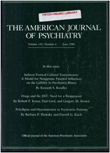"Hidden" eating disorders in Scottish psychiatric inpatients
Abstract
The authors designed a study to determine the prevalence of "hidden" eating disorders among a large group of hospitalized psychiatric patients. Of 146 patients surveyed, 13.8% currently had eating disorders diagnosed according to DSM-III criteria: 7.3% had bulimia, 3.6% had anorexia nervosa, and 2.9% had an atypical disorder. Eighty percent of the bulimic patients and all of the patients with an atypical disorder had not been so identified by hospital diagnosis. Eating-disordered patients tended to have concurrent diagnoses of affective or personality disorders.
Access content
To read the fulltext, please use one of the options below to sign in or purchase access.- Personal login
- Institutional Login
- Sign in via OpenAthens
- Register for access
-
Please login/register if you wish to pair your device and check access availability.
Not a subscriber?
PsychiatryOnline subscription options offer access to the DSM-5 library, books, journals, CME, and patient resources. This all-in-one virtual library provides psychiatrists and mental health professionals with key resources for diagnosis, treatment, research, and professional development.
Need more help? PsychiatryOnline Customer Service may be reached by emailing [email protected] or by calling 800-368-5777 (in the U.S.) or 703-907-7322 (outside the U.S.).



